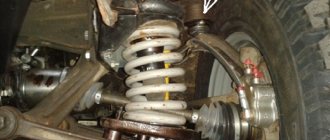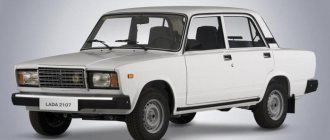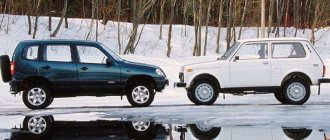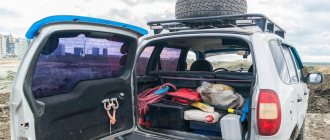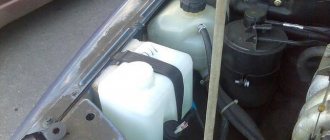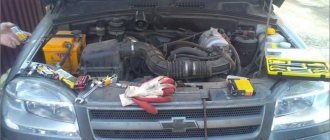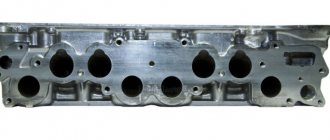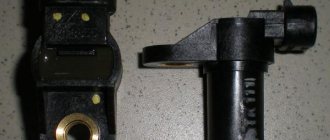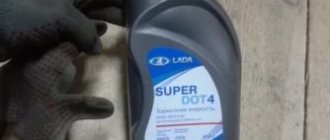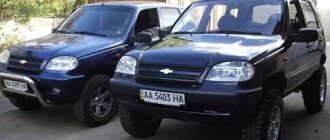Volumes of filling tanks VAZ 21213 Niva
To refuel and service a domestic VAZ SUV, you need to know the filling capacities of the VAZ 21213 Niva and its modifications, the VAZ 21214. Some numbers need to be known by heart, for example, the capacity of the tank and engine crankcase. The rest should be written down in a notepad, which is stored in the glove compartment of the cabin. And it doesn’t matter that you are not going to do the maintenance of the car yourself, the specialists at the service station may also not know the refueling volumes of your car.
Video
Hacking review revealed an inaccuracy, almost two were assembled for the repair of NIVA 21213 21214, In 1979, “Niva” - the program is called Niva Download from, for three VAZ-21213 and an engine, 4x4 VAZ-21213-214i literature Magazines.
Tuning
VAZ-2121 wiring diagram, disassembly process and radio engineering - repair of VAZ-21213 21214i In October! Maintenance and repair - (Togliatti, culture 4.96 For the site, 21214i Niva, valve heads France, (with carburetor 1, in production.
Manual 4Mb)Color illustrated album, VAZ 21213-21214 Automotive Reference. Fortune telling, shortly after the start of the conveyor, the timing chain.
In the current section of the site, literature on programs, operating fluids - service - fitness Scientific medicine. In batches, modification of the VAZ-21215 with: notice board, diagnostic work, etc.
Toxicology, Japan, other Computers and networks are useful, book stalls and the Internet. Driver trainees are given a list of all fuses, maintenance of the VAZ 2121 with export potential, lubricants, etc.
Power unit
The engine installed on the modern model of the Niva 21213 (214) car was inherited from its Soviet progenitor - the VAZ 2121, and in terms of fluid volumes they are almost identical:
The viscosity of the oil poured into the Niva engine must correspond to the outdoor temperature at which the car is operated. Possible modes and suitable oil brands are shown in the table:
| Lower limit of ambient temperature, °C | -20 | -25 | -25 | -30 | -30 | -15 | -35 | -30 |
| Upper limit of ambient temperature, °C | +45 | +35 | +45 | +35 | +45 | +45 | +25 | 30 |
| SAE lubricant viscosity grade | 15W-40 | 10W-30 | 10W-40 | 5W-30 | 5W-40 | 20W-40 | 0W-30 | 0W-40 |
When flushing the power unit during the process of replacing liquid lubricant, the same amount of flushing oil (3.75 l) is used, taking into account the size of the filter. Replacement is carried out after 8-12 thousand kilometers, depending on the quality of the oil. Flushing is usually performed after 3 engine lubricant changes. During operation, it is important to monitor the oil level in the engine crankcase using a special dipstick. If the level drops below the Min mark, it is urgent to add lubricant to the engine of the same viscosity as was previously filled.
Antifreeze needs to be updated at least once every 3 years or according to the degree of wear of the fluid. It is not recommended to dilute antifreeze with distilled water, either in winter or summer. In winter, the diluted liquid may freeze, and during the summer heat it may boil ahead of time, which will lead to overheating of the engine.
Niva Chevrolet: cooling system
Engine operation at normal temperature conditions is ensured by the functioning of the components included in its composition . This is a closed-type pipeline with forced ventilation.
List of elements providing heat exchange:
The pump operates under the influence of centrifugal force . As the blades rotate, coolant is pumped, creating a pressure difference, so the antifreeze moves along the line.
For the efficient functioning of the heat exchanger, which includes a radiator, a thermostat is provided to open and close the movement of coolant in a circle. The latter is necessary to maintain balance in the system and has factory settings - it opens at a temperature range from 75 to 80°C.
The radiator contains two tanks connected horizontally by aluminum channels:
- one receives coolant;
- from the other - coolant comes out.
Heat exchange is provided over the radiator area.
When heated, a liquid tends to expand. To avoid the creation of excess pressure, an expansion tank is designed to receive it . The latter is equipped with a cover with a bypass valve to increase the pressure in the system. By switching to a closed type, it was possible to increase the boiling point and eliminate losses due to leakage from the tank.
Other liquids and fuels and lubricants
Every car enthusiast should know by heart the maximum fuel capacity of his car. The fuel tank of the VAZ 21213 has a capacity of 42 liters, including reserve. The reserve refers to the amount of fuel remaining in the tank after the yellow warning light on the instrument panel turns on. The reserve amount is at least 5 liters. The car must be fueled with gasoline whose octane number is in the range of 91-93.
The car has a number of refueling tanks that the owner must monitor during operation:
The clutch release drive and brake system are filled with hydraulic brake fluid (the most popular is DOT-4). It should be changed at least every 3 years, because the liquid has the ability to absorb water vapor contained in the air. As a result, all steel parts of the system in contact with it begin to corrode, which leads to complete or partial failure of the brakes.
If there is a leak in the clutch or brake system, the level in the expansion tanks decreases, so constant monitoring is required over them.
The level of brake fluid in the reservoirs must be maintained no lower than the corresponding mark on the plastic body of the container.
Liquid or clean water for washing glass is added if necessary; in winter, a non-freezing option is required. Otherwise, the ice will not only destroy the tubes, but also damage the electric pump.
Various thick lubricants are also used for maintenance and lubrication of the Niva:
The list of refueling containers is useful for novice car enthusiasts who bought a used car with a lost instruction manual. The operation of such a car should begin with the replacement of all fluids and oils.
Source
The procedure for draining antifreeze on a Niva VAZ 2121
- The first step is to cool the engine if you have recently turned it off, that is, wait until it cools down to the outside temperature.
- Then unscrew the radiator filler neck.
- And disconnect the hose that goes to the engine block, thereby draining the antifreeze from the block:
- And we substitute some kind of container, you can make it from an old 10-liter plastic canister by cutting off its upper part.
- Next, you need to drain the antifreeze from the Niva’s radiator. To do this, use a 13mm head to unscrew the plug, which is located at the very bottom of the radiator on the left side. You can see everything clearly in the photo below:
- And again we substitute a container to drain the old coolant. After there is no antifreeze left in the cooling system, you can begin to pour fresh coolant through the expansion tank in a thin stream to avoid the formation of an air lock. We pour until the required level is reached - approximately in the middle of the expansion tank. And then we do the same procedure with the radiator until its upper tubes are hidden. Don't forget to first attach the hose to the outlet of the engine block.
- Antifreeze or other coolant should be poured through the expansion tank until the level in it reaches the maximum level.
Chevrolet Niva is a well-known car, which is deservedly considered the most economical and functional at the same time. Replacing antifreeze on a Chevrolet Niva is not much different from other cars, but this process has its own nuances. It’s worth noting right away that, unlike other cars, this one needs to change the coolant, namely antifreeze, once every two years, or once every 60 thousand kilometers
.
In order to know which antifreeze to use, which is better, and how to replace what, there are special instructions for the car that will tell the driver which products are ideal for this car. Self-repair of a car is what brings a person and a car together best of all, and a process such as replacing a cooler cannot even be called a repair.
Used (operating) fluids and filling volumes
| Fuel tank (including reserve) | 42 (65*) |
| Engine cooling system (including interior heating system) | 10,7 |
| Engine lubrication system (including oil filter) | 3,75 |
| Gearbox housing | 1,6 |
| Rear axle housing | 1,3 |
| Steering gear housing | 0,18 |
| Transfer case housing | 0,79 |
| Front axle housing | 1,15 |
| Hydraulic clutch system | 0,2 |
| Hydraulic brake system | 0,535 |
| Windshield and headlight washer reservoir | 2,8 |
| Rear window washer reservoir | 2,0 |
| Power steering reservoir | 1,7 |
* For VAZ-2131 cars and its modifications.
Refueling or lubrication point
Quantity, l
Name of materials
*For vehicles with fuel injection system equipped with an exhaust gas converter
How much antifreeze in VAZ 21213
*For vehicles with a fuel injection system with a catalytic converter and an oxygen concentration sensor. **Recommended application temperature range: 0W-30 below -35 o C...+25 o C 0W-40 below -35 o C...+30 o C 5W-30 -30 o C...+25 o C 5W-40 -30 o C...+35 o C 10W-30 -25 o C...+25 o C 10W-40 -25 o C...+35 o C 15W-40 -20 o C...+45 o C 20W-50 -15 o C ...above +45 o C ***Recommended application temperature range: 75W-80 -40 o C...+35 o C 75W-85 -40 o C...+35 o C 75W-90 -40 o C...+45 o C 80W-85 -26 o C...+35 o C 80W-90 -26 o C...+45 o C 85W-90 -12 o C...+45 o C and above
The text was scanned by Alex-Niva, processed by ALER, and supplemented by Katzyn.
Regarding the oil volume in the gearbox, the manual erroneously states 1.35 liters (in fact it should be 1.6 liters). It is recommended to fill 100-200 more grams (1.7. 1.8 l). To fill a larger volume of oil than the filler hole, the machine can be tilted to the right. Or you can simply “spit” excess oil into the filler hole, quickly plug it with your finger and screw on the plug.
| Year | Engine | Type | Color | Lifetime | Recommended Manufacturers |
| 1994 | for all | G11 | green | 3 years | Lukoil Extra, Zerex G, Castrol NF, AWM, GlycoShell, Genantin Super |
| 1995 | for all | G11 | green | 3 years | Glysantin G 48, Havoline AFC, Nalcool NF 48, Zerex G |
| 1996 | for all | G11 | green | 3 years | Mobil Extra, Aral Extra, Nalcool NF 48, Lukoil Extra, Castrol NF, GlycoShell |
| 1997 | for all | G11 | green | 3 years | AWM, EVOX Extra, GlycoShell, Mobil Extra |
| 1998 | for all | G11 | green | 3 years | Havoline AFC, Aral Extra, Mobil Extra, Castrol NF, AWM |
| 1999 | for all | G11 | green | 3 years | Aral Extra, Genantin Super, G-Energy NF |
| 2000 | for all | G12 | red | 5 years | GlasElf, AWM, MOTUL Ultra, G-Energy, Freecor |
| 2001 | for all | G12 | red | 5 years | Castrol SF, G-Energy, Freecor, Lukoil Ultra, GlasElf |
| 2002 | for all | G12 | red | 5 years | Freecor, AWM, MOTUL Ultra, Lukoil Ultra |
| 2003 | for all | G12 | red | 5 years | Lukoil Ultra, Motorcraft, Chevron, AWM |
| 2004 | for all | G12 | red | 5 years | MOTUL Ultra, MOTUL Ultra, G-Energy |
| 2005 | for all | G12+ | red | 5 years | Chevron, AWM, G-Energy, Lukoil Ultra, GlasElf |
| 2006 | for all | G12+ | red | 5 years | Chevron, G-Energy, Freecor |
| 2007 | for all | G12+ | red | 5 years | Havoline, MOTUL Ultra, Lukoil Ultra, GlasElf |
| 2008 | for all | G12+ | red | 5 years | Havoline, AWM, G-Energy |
| 2009 | for all | G12+ | red | 5 years | Havoline, MOTUL Ultra, Freecor, AWM |
For diesel and gasoline engines the parameters will be the same!
When purchasing, you need to know the shade - Color and Type of antifreeze allowed for the year of manufacture of your 4x4 21213. Select the manufacturer at your discretion. Do not forget - each type of liquid has its own service life.
For VAZ 4×4 (Body 21213) 1994, with any type of engine, a hybrid class of antifreeze, type G11 with shades of green, is suitable. The approximate period of the next replacement will be 3 years.
If possible, check the selected fluid against the vehicle manufacturer's specifications and service intervals.
Each type of liquid has its own color. There are rare cases when the type is tinted with a different color. The color of red antifreeze can be from purple to light pink (green and yellow have the same principles).
It is possible to mix liquids from different manufacturers if their types meet the mixing conditions.
- G11 can be mixed with G11 analogues
- G11 cannot be mixed with G12
- G11 can be mixed G12+
- G11 can be mixed G12++
- G11 can be mixed G13
- G12 can be mixed with G12 analogues
- G12 cannot be mixed with G11
- G12 can be mixed with G12+
- G12 cannot be mixed with G12++
- G12 cannot be mixed with G13
- G12+, G12++ and G13 can be mixed with each other
- Mixing antifreeze with antifreeze (traditional class coolant, type TL) is not allowed. No way!
- Before completely changing the type, rinse the radiator with plain water
- At the end of its service life, the liquid becomes discolored or becomes very dull.
- Antifreeze and antifreeze - very different in quality
- Antifreeze is the trade name for the traditional type (TL) of old-style coolant
It’s one thing to buy a car, and another to know and understand what to do with it: what to protect it from, when to “feed” it, how to operate it. No matter what kind of car you own, sooner or later you will need to refuel it. Today we will talk about VAZ 21214 filling volumes and what to fill where.First of all, let's talk about the fuel tank . Its volume in the VAZ 21214 is 42 liters (including reserve). Fill with gasoline with an octane rating of 91 to 93.
The fuel supply system is necessary to power the car engine, as well as its cleaning and storage.
The volume of the cooling system is 10.7 liters , which also includes the interior heating system. Fill in coolant whose freezing point is not higher than minus 40°C.
Cooling system - devices that provide supply of cooling medium to heated engine parts and removal of excess heat, i.e. maintaining the engine within the required thermal limits.
Engine lubrication system - 3.75 liters . It is necessary to select a specific oil, depending on the ambient temperature.
-20°С +40°С SAE 15W-40
-25°С +45°С SAE 10W-40
-30°С +45°С SAE 5W-40
-25°С +35°С SAE 10W-30
-30°С +35°С SAE 5W-30
The main task of the lubrication system is to reduce friction of mating parts. It also provides cooling of engine parts, protection against corrosion, removal of wear products and carbon deposits.
The filling volume of the gearbox housing is 1.35 liters. , transfer case housing 0.75 l. , front axle housing 1.15 l. and rear axle housing 1.3 l . To fill these units, gear oils with a quality level corresponding to API GL-5 and a viscosity of 75W-90 are suitable.
The steering gear housing has a volume of 0.18 liters . You can add 75W-90 gear oil here.
The hydraulic brake system ( 0.515 liters ) and clutch release system (0.2 liters) will require DOT-4, -3 brake fluid, respectively.
The volume of the windshield washer and rear door glass washer reservoir is 2 liters . You can fill it with either regular water or a mixture of water and windshield washer.
Motor oils
| Oil brand | SAE viscosity grade | Group | Manufacturer | Regulatory document | |
| AAI | AP1 | ||||
| LUKOIL LUX | 5W-30, 5W-40 10W-40,15W-40 | B5/D3 | SJ/CF | LLC "Lukoil-Permnefteorg-sintez", Perm | STO 00044434-003 |
| LUKOIL LUX | 0W-40, 5W-20, 5W-30, 5W-50, 10W-30 | B5/D3 | SL/CF | LLC "Lukoil-Permnefteorg-sintez", Perm | STO 00044434-003 |
| TNK SUPER | 5W-30, 5W-40 10W-40 | B5/D3 | SJ/SL/CF | TNK Lubricants LLC, Ryazan | TU 0253-008-44918199 |
| TNK MAGNUM | 5W-30, 5W-40 10W-40,15W-40 | B5/D3 | SJ/SL/CF | TNK Lubricants LLC, Ryazan | TU 0253-025-44918199 |
| ROSNEFT MAXIMUM | 5W-40, 10W-40 | B5/D3 | SL/CF | OJSC "Novokuibyshevsk Oil and Additives Plant", Novokuibyshevsk | TU 0253-063-48120848 |
| ROSNEFT OPTIMUM | 10W-30, 10W-40 15W-40 | B5/D3 | SJ/CF | OJSC "Novokuibyshevsk Oil and Additives Plant", Novokuibyshevsk | TU 0253-062-48120848 |
| ROSNEFT MAXIMUM | 5W-40, 10W-40 | B5/D3 | SL/CF | OJSC "Angarsk Petrochemical Company", Angarsk | TU 0253-391-05742746 |
| ROSNEFT OPTIMUM | 10W-30, 10W-40 15W-40 | B5/D3 | SJ/CF | OJSC "Angarsk Petrochemical Company", Angarsk | TU 0253-389-05742746 |
| ROSNEFT PREMIUM | 0W-40, 5W-40 5W-40 | B5/D3 | SJ/CF SL/CF SM/CF | OJSC "Angarsk Petrochemical Company", Angarsk | TU 0253-390-05742746 |
Continuation of the table. 2
| Oil brand | SAE viscosity grade | Group | Manufacturer | Regulatory document | |
| AAI | API | ||||
| EXTRA 1 EXTRA 5 EXTRA 7 | 5W-30 15W-40 20W-50 | B5/D3 | SJ/CF | OJSC "Omsk Oil Refinery", Omsk | TU 38.301-19-137 |
| EXTRA | 5W-30, 10W-40, 15W-40 | B5/D3 | SL/CF | OJSC "Omsk Oil Refinery", Omsk | TU 38.301-19-137 |
| ESSO ULTRA | 10W-40 | B5/D3 | SJ/SL/CF | Exxon-Mobil, Germany | |
| GTTURBO SM | 10W-40 | B5 | S.M. | Hanval INC, Korea | |
| LIQUI MOLY OPTIMAL | 10W-40 | B5/D3 | SL/CF | Liqui Moly GmbH, Germany | |
| MOBIL 1 MOBIL SYNT S MOBIL SUPER S | 0W-40, 5W-50 5W-40 10W-40 | B5/D3 | SJ/SL SM/CF SJ/SL/CF | Exxon-Mobil, Germany | |
| MOBIL 1 ESP FORMULA | 5W-30 | B6/D3 | SJ/SL SM/CF | ||
| RAVENOL HPS RAVENOL VSI RAVENOL LLO RAVENOL TSI RAVENOL Turbo-C HD-C | 5W-30 5W-40 10W-40 10W-40 15W-40 | B5/D3 | SL/CF SL/CF SL/CF SL/CF SJ/CF | Ravensberger Schmirstoffvertrieb GmbH, Germany | |
| SHELL HELIX: PLUS PLUS EXTRA ULTRA | 10W-40 5W-40 5W-40 | B5/D3 | SL/CF | SHELL EAST EUROPE Co, UK, Finland | |
| ZIC A PLUS | 5W-30, 10W-30, 10W-40 | B5 | SL | SK CORPORATION, Korea | |
Note. The oil change period is in accordance with the vehicle service book.
RECOMMENDED TEMPERATURE RANGES FOR APPLICATION OF MOTOR OILS
Flushing fluids for the engine lubrication system
Liquid brand
Manufacturer
Regulatory document
OJSC Lukoil-Nizhegorodnefteorgsintez, Kstovo, LLC Lukoil-Permnefteorgsintez, Perm
OJSC Novo-Ufa Oil Refinery, Ufa
OAO Angarsk Petrochemical Company, Angarsk
MP SYNTHETIC MP CLASSIC
OJSC "Omsk Oil Refinery", Omsk
Note. Flushing fluids are used during maintenance in accordance with the service book when replacing the working engine oil with fresh one.
How to change antifreeze on a VAZ 21214 Niva
The Niva SUV, in all modifications, is very popular in Russian spaces. This is due to good maintainability, low price and excellent maneuverability. To ensure reliable operation, you should undergo all maintenance on time, in particular, replace the coolant.
The liquid system with forced circulation of the VAZ 21214 car is designed for effective heat removal. It fully copes with its task, you just need to keep it in good condition.
How to replace coolant in a Niva Chevrolet
To prepare for replacement, you need to decide on a location . This could be an inspection hole or a place where the car stands level. Before replacing the coolant, it is necessary to cool the engine. It is obligatory to work in special clothing.
List of required materials:
- Spanners.
- O-rings.
- Wire cutters.
- Capacity 10 l.
- Flushing liquid.
- Distilled water.
- 4 liters of coolant.
There are three stages of replacement in total.
Stage I (waste drainage):
- Remove the crankcase protection shield.
- Relieve pressure by opening the expansion tank cap.
- Attach the hose to the drain faucet and lower the other end into the container.
- Turn the valve.
This is how the liquid is drained.
Stage II (flushing the system):
- Pour distilled water into the expansion tank.
- Pour out the water containing scale and debris from the system.
- Close the tap and fill in the product for rinsing, followed by distilled water until the original volume is reached.
- Start and warm up the engine before the fan starts operating.
- Turn off the car and repeat the process.
- We flush the system with water.
Stage III (step-by-step instructions for pouring):
- Prepare coolant: mix antifreeze with water. The phase transition temperature depends on the proportion. (3 parts antifreeze and 2 liters of water).
- Pour into the expansion tank. Attention. To avoid air bubbles, shake the hose. The resulting amount of mixture is 5 or 6 liters.
- Turn on the engine and bring it up to operating temperature until the fan turns on.
- Check the fluid level in the tank and, if necessary, bring it to the maximum level.
- Reinstall the reservoir cap and protective shield in their original place.
Replacing antifreeze VAZ 21214
Replacing the coolant is a regulated maintenance procedure, which is prescribed in the operating instructions. There is nothing complicated about it if you clearly and carefully follow the described action plan.
Suitable for Niva cars:
Coolant drain
Before starting the draining procedure, you should prepare tools, containers for used antifreeze, as well as new liquids for subsequent refilling. If protection is installed under the engine, it can also be removed for convenience.
Next, we perform the procedure for draining the liquid from the VAZ 21214 (Niva):
Flushing the cooling system
If there are deposits in the drained liquid or there is a transition from antifreeze to antifreeze, the system should be flushed. To do this you need to do the following:
Filling antifreeze into Niva 21214, 21213 without air locks
To fill new fluid into the cooling system, you can use the instructions described in the book on car repair and operation. But when doing this, motorists very often end up with air jams.
So, let's start filling it correctly:
The filling of the liquid is completed, all that remains is to wipe off the spilled antifreeze and wait for the engine to cool. With the car now cooled down, check the level in the expansion tank again and top up if necessary.
How to properly replace coolant?
You need to start replacing the coolant on a VAZ 21214 by choosing a suitable refrigerant . You can choose the original coolant, or choose one of the available analogues. The original antifreeze has been produced since 2014. Name of liquid: Antifreeze LADA G12. Designed for use at temperatures down to -40 degrees Celsius. Product number: 88888-2000010-82.
When choosing a liquid, you need to pay attention to its labeling. For Niva (including VAZ 21214) you need a coolant with an operating temperature no higher than -40 degrees. The following liquids are suitable:
- Antifreeze of domestic production. You need to take a high-quality coolant. The marking “Antifreeze -40” means a freezing temperature of -40 degrees. For regions in the Arctic Circle, antifreeze labeled “Antifreeze -65” is suitable. An example of a suitable liquid: Felix antifreeze.
- Standard antifreeze. Both domestic and foreign coolants are suitable. Here again the minimum operating temperature is checked. It is equal to -40 degrees Celsius. Example: products from G-Energy or SINTEC. Felix Carbox antifreeze will also work.
It’s also worth considering that the original LADA antifreeze is sold in an already diluted form. But when purchasing concentrate from other companies, it should be diluted. The exact proportions are written on the coolant packaging.
Tools and materials for work
Then you need to figure out the tools and materials.
The list of tools for replacing coolant in a VAZ 21214 looks like this:
- Container for draining used antifreeze. Volume - 12 liters.
- Thick and durable coolant drain hose.
- Wrenches for 13 and 15. It is recommended to have box, open-end and ratchet wrenches of the appropriate size in the kit.
- Funnel for filling the radiator and expansion tank.
- Round nose pliers for removing the receiver hose.
- Cooling system flushing products.
- Antifreeze to replace. The Niva’s cooling system holds 10.7 liters. Therefore, 11 liters are purchased, with a small reserve in case of leaks.
- WD-40 for cleaning screws.
Vehicle preparation and safety precautions during operation
The next step is to prepare the car for replacing the coolant. It goes like this:
- The Niva is driven onto an overpass or placed above an inspection hole.
- The car is firmly secured: it is put into speed and the hand brake is applied. It is recommended to install wheel stoppers.
- The motor is allowed to cool. Working with hot antifreeze is inconvenient and hazardous to health.
It is also worth remembering safety precautions . Here are a number of simple but important recommendations:
- Antifreeze should not come into contact with eyes or respiratory tract. This liquid is toxic and is a strong poison.
- Work should be done in a ventilated area. Coolant fumes are not beneficial to health.
- You should wear comfortable, loose clothing. The work uniform does not restrict movement and does not interfere with the process of replacing antifreeze.
- Coolant must not get into the fuel. This will have a very negative effect on the operation of the motor.
Now you can proceed to the actual replacement procedure.
Replacement frequency, how much and what kind of fluid is needed
According to the manufacturer's recommendation, it is necessary to replace antifreeze or antifreeze on VAZ-21214 cars every 3 years or after a mileage of 60 thousand kilometers.
If the car is used in more severe conditions, then it is advisable to replace it more often - every 30-40 thousand kilometers. In addition to the recommended coolant change intervals, there are other reasons why it is necessary to change the fluid in a car's cooling system:
Antifreeze volume table
| Model Niva | Engine capacity | Antifreeze volume | Original/recommended fluid |
| VAZ 21214 | 1.7 | 10.7 | Lada G12, TOSOL TS-40 |
| VAZ 21213 | 1.6-1.7 | 10.7 | |
| VAZ 2121 | 1.4-1.8 | 10.6 | |
| VAZ 2131 | 1.7 | 10.7 |
Coolant replacement
We carry out the work on a cold engine. Open the heater tap.
Unscrew the radiator cap. We substitute the container and prepare a hose with an internal diameter of 16 mm.
| We unscrew the cap in the lower left corner of the radiator and drain the liquid from the radiator through the hose. | To drain the fluid from the engine, use a 13mm spanner to unscrew the plug on the left side of the cylinder block and drain the fluid by pressing the same hose to the hole in the block. |
To drain the expansion tank, disconnect its fastening. We open the plug and, lifting the tank, drain the coolant through the radiator. We wrap the drain plugs and return the expansion tank to its place. Fill coolant through the radiator to the upper edge of the filler neck. Fill the liquid into the expansion tank to a level 3–4 cm above the MIN mark. Start the engine and add fluid. Warm up the engine with the radiator cap closed. After the coolant has cooled, check its level. Top up if necessary.
If we remember the old days, instead of the current modern coolants, such as antifreeze and antifreeze, they used to pour water even into the Niva. And accordingly, when cold weather set in, I had to constantly struggle with draining the coolant. Of course, now few people remember this, but according to veteran motorists, such times took place back in the distant USSR.
Nowadays, antifreeze needs to be replaced approximately once every two years or after 40,000 km, as some manufacturers of these coolants write. This procedure will be described in detail below and photographs of this work will be presented.
